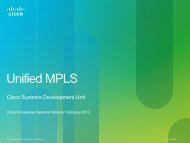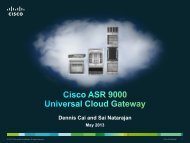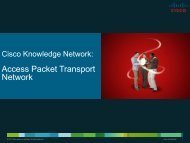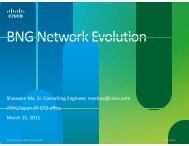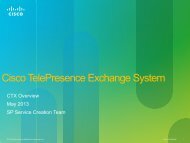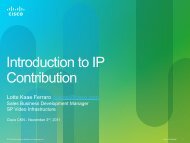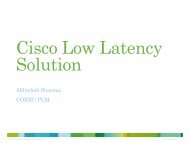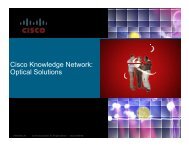Network Evolution 2011 - 2020 Scenario Analysis - Cisco ...
Network Evolution 2011 - 2020 Scenario Analysis - Cisco ...
Network Evolution 2011 - 2020 Scenario Analysis - Cisco ...
You also want an ePaper? Increase the reach of your titles
YUMPU automatically turns print PDFs into web optimized ePapers that Google loves.
<strong>Network</strong> <strong>Evolution</strong><strong>2011</strong> - <strong>2020</strong><strong>Scenario</strong> <strong>Analysis</strong>Steve CondraCable Access Business UnitApril 2012© <strong>2011</strong> <strong>Cisco</strong> and/or its affiliates. All rights reserved. 1
• Voice, Video, and Data, all sharing a common infrastructure…<strong>Network</strong> Convergence.• Less stranded capacity since spectrum, equipment, power, space,and infrastructure are all shared across all services to allcustomers.• With all IP comes mobility… any media, any content, any place,any time.• With all IP comes open standards and feature velocity… moresuppliers providing feature rich solutions.• With all IP comes incredible bandwidth (spectrum) efficiency.© <strong>2011</strong> <strong>Cisco</strong> and/or its affiliates. All rights reserved. 2
0 MHz0 MHz0 MHz42 541000 MHz42 541000 MHz42 541000 MHzDocsis Docsis Docsis HSD HSD Analog SD HSD Video Video IP Video (MPEG4) HD Video Free Spectrum = SD 700 HSD Video MHzVOD Free HD Sepctrum Video = 500 MHzHSD VOD Free Spectrum = 140 MHz750 MHz750 MHz750 MHz860860860Analog IP Typical Video Reclamation 870 RF Spectrum MHz Plant Efficiency••• This IP 60 Video Channels graphic is assumed shows Analog 100% to be reclamation MPEG4 (doubles using DTA’s the RF but spectrum reducing efficiency) to 10-30•• Channels IP 20 Video Channels is is streamed more Digital realistic SD on request Video (240 only streams) (if nobody is watching that stream it• takes 40 Channels no spectrum) Digital HD Video (80 streams)•• IP 8 Channels Video utilizes of Docsis ABR to Downstream customize the bandwidth to the device• requirements.8 Channels of VOD• IP Video utilizes VBR to refresh the screen based on the video motionrequirements• IP Video utilizes stat muxing© <strong>2011</strong> <strong>Cisco</strong> and/or its affiliates. All rights reserved. 3
• Service Group size = 400 HHP• IP Video subscribers = 50% = (200)• Tuners per subscriber = 5• Tuner profile ranges from 1 to 7 Mbps (average = 4.5 Mbps)• Reasonable simultaneous users … ~ 50% of all tuners in allsubscribers are on a peak periods• No Multicast gain factored at this time… all UnicastConclusion: A converged all IP network will enable hugefeature benefits, improved feature velocity, and will alsoprovide tremendous RF spectrum efficiency improvement© <strong>2011</strong> <strong>Cisco</strong> and/or its affiliates. All rights reserved. 4
1. How will demand for HSD and IP Video Grow?2. Will our migration plans allow us to do both linearvideo and IP video during the transition to an all IP<strong>Network</strong>?© <strong>2011</strong> <strong>Cisco</strong> and/or its affiliates. All rights reserved. 5
• <strong>Scenario</strong> for managing downstream bandwidth,legacy video, IP video, and HSD.• Bandwidth model assumptions:• 400 HHP Node• IP video grows to 50% penetration, 5 tuners per home• HSD grows from 32% to 50% penetration• HSD rates grow at 40% CAGR (Compounded annual growth rate)• Pending upstream bandwidth issues, oneestimate on when.• Bandwidth model assumptions:• HSD penetration grows from 32% to 50%• HSD rates grow at 40% CAGR• Dialogue… what to do?© <strong>2011</strong> <strong>Cisco</strong> and/or its affiliates. All rights reserved. 6
• This is a typical North American HFC evolution for a 750 MHzplant from today through <strong>2020</strong>.• This analysis assumes HSD growth at 40% per year CAGR.• Service group starts a 920 Homes (two nodes at 460 HHP each)• IP Video Service grows to 50% penetration and 8 tuners perhome by the year <strong>2020</strong>.• This analysis seeks the lowest cost of ownership to account forthe growth described above…© <strong>2011</strong> <strong>Cisco</strong> and/or its affiliates. All rights reserved. 7
• 920 hhp service groups (2x nodes/SG)• HSD data scales at 50% penetration ofhhp throughout the modeling period• 240 Kbps per HSD sub @ 40% CAGR• 100 Kbps per US HSD sub @ 30%CAGR• Current VoD service scale from 4 to 14QAM channels per service group• Total Channel requirement grows to180+… (before any other plantchanges and before any IP Video)© <strong>2011</strong> <strong>Cisco</strong> and/or its affiliates. All rights reserved. 8
IP Video QAM Channels by Year180160140120QAM Channels100806040200<strong>2011</strong> 2012 2013 2014 2015 2016 2017 2018 2019 <strong>2020</strong>UC/MC VBR 3 4 8 14 19 29 37 45 59 75U'Cast VBR 3 4 10 16 23 37 52 67 89 116U'Cast CBR 5 6 15 24 33 54 76 96 129 167© <strong>2011</strong> <strong>Cisco</strong> and/or its affiliates. All rights reserved. 9
Growth• If 920 hhp service groups aremaintained the growth alone willrequire 130+ additional channels• Estimates include all managed andunmanaged video devicesWhat tools can be utilized tomanage the need for 300+QAM channels?• Node Splits• Analog reclamationTotal© <strong>2011</strong> <strong>Cisco</strong> and/or its affiliates. All rights reserved. 10
• QAM Channel Growth approaches 300Channels through the next 10 years• HSD 4 to 55 Channels• IPTV 0 to 75 Channels• B’Cast Digital 33 to 54 Channels• Upstream 4 to 19 Channels• VOD 4 to 14 Channels• HFC Tools Recommended are:• Analog Reclamation (DTA) 65 to 10• Node Splits (960 to 128 Homes/Node)920460 250 250250125125920460460© <strong>2011</strong> <strong>Cisco</strong> and/or its affiliates. All rights reserved. 11
• Utilization of HFC and DOCSIS tools provides a mechanism forefficient network scalabilty§ Analog channel reclamation§ Node segmention to the 128 hhp level§ Modest VBR encoding efficency§ Multicast gain that varies based on service group reduction• Node segmentation is driven primarily by the need for additionalupstream spectrum§ Creates an abundance of downstream spectrum• IP acknowledgments can burden the upstream spectrum due tohigh levels of video penetration or large service groups§ Primarily a function of unicast video traffic© <strong>2011</strong> <strong>Cisco</strong> and/or its affiliates. All rights reserved. 12
• At some point… linear video will disappear. The next step will bedigital broadcast reclamation and move embedded basecustomers to IP Video.§ In this analysis there are 54 out of 110 Channels tied up in broadcast. (50%)§ Some or all of those broadcast channels can be eliminated by moving all thecustomers to IP video.• This analysis supports 1 Gbps downstream peak data ratecapability starting in 2015… at some point 1 Gbps upstream peakdata rate will be required.§ No timing is assumed or represented on that subject in this analysis.© <strong>2011</strong> <strong>Cisco</strong> and/or its affiliates. All rights reserved. 13
Q&AThank you.
© 2010 <strong>Cisco</strong> and/or its affiliates. All rights reserved. 15






